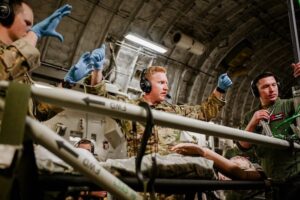
Story by Maj. John Stamm
908th Airlift Wing Public Affairs
When severely injured, wounded or sick service members require transportation via airlift, medical care can’t stop mid-flight.
As senior members of aeromedical evacuation teams, it’s the responsibility of U.S. Air Force flight nurses, Air Force specialty code 46NXF, to provide life-saving emergency and pre-hospital care to servicemembers up to 30 thousand feet in the sky.
From planning a mission to disembarking the aircraft, flight nurses function as members of a critical care transport team and provide comprehensive care during aeromedical evacuation missions. Responsibilities incorporate patient assessment and triage, stabilization, critical care intervention techniques, intensive care monitoring and advanced surgical skill procedures that include neonates through geriatric age groups.
Flight nurses may also be expected to execute independent judgment to deliver appropriate care when contact with a medical command physician is not possible.
“It’s like you are in a flying emergency room, but you don’t have the same resources,” said Capt. Christopher Bennett, 908th AES flight nurse. “You’ve got to be very resourceful and find innovative ways to compensate.”
Responsible for advanced emergency care patient management during air transport of the critically ill or injured from the scene or outlying sites to participating secondary and tertiary care institutions, becoming a flight nurse requires experience and education beyond that of a typical registered nurse.
“You can’t just take an ER nurse and put them on an aircraft; it’s a bit more complicated than that,” said Capt. Kristian Taylor, 908th AES flight nurse. “It all starts with having a four-year degree, and then it’s a two-to-three-year process [of additional military training] after that.”
It also is a physically and emotionally demanding profession that has more elements of danger than working in a traditional stationary hospital.
“That’s why, when we conduct our training missions, we throw in increasing levels of stress where we can control it, so we know our limits and what we’re capable of before we go operational,” Bennett added.
Candidates for this career field must be between the ages of 18 and 47, possess a bachelor’s degree in nursing from an accredited school and a have valid U.S. or U.S. territory registered nurse license. They must also be medically cleared for flight, understand the principles of drug therapy and the effects of altitude, and be accepted by the medical unit commander and Air Force Reserve Surgeon General.
“It’s worth noting that the Air Force Reserve and the Air National Guard execute 80% of all aeromedical evacuations for the Department of Defense around the world,” said Bennett. “So, we get exceptional leadership opportunities and develop skills you won’t learn in the civilian sector, which makes us even better civilian practitioners.”